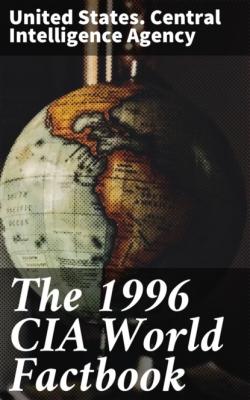The 1996 CIA World Factbook. United States. Central Intelligence Agency
Читать онлайн.| Название | The 1996 CIA World Factbook |
|---|---|
| Автор произведения | United States. Central Intelligence Agency |
| Жанр | Социология |
| Серия | |
| Издательство | Социология |
| Год выпуска | 0 |
| isbn | 4057664582324 |
Jean-Michael BOKAMBA-YANGOUMA, leader
Other political or pressure groups: Union of Congolese Socialist
Youth (UJSC); Congolese Trade Union Congress (CSC); Revolutionary
Union of Congolese Women (URFC); General Union of Congolese Pupils
and Students (UGEEC)
International organization participation: ACCT, ACP, AfDB, BDEAC,
CCC, CEEAC, ECA, FAO, FZ, G-77, IBRD, ICAO, ICRM, IDA, IFAD, IFC,
IFRCS, ILO, IMF, IMO, Intelsat, Interpol, IOC, ITU, NAM, OAU, UDEAC,
UN, UNAMIR, UNAVEM III, UNCTAD, UNESCO, UNIDO, UPU, WFTU, WHO, WIPO,
WMO, WToO
Diplomatic representation in US:
chief of mission: Ambassador (vacant); Charge d'Affaires Daniel
MOUELLET
chancery: 4891 Colorado Avenue NW, Washington, DC 20011
telephone: [1] (202) 726–0825
FAX: [1] (202) 726–1860
US diplomatic representation:
chief of mission: Ambassador William C. RAMSEY
embassy: Avenue Amilcar Cabral, Brazzaville
mailing address: B. P. 1015, Brazzaville
telephone: [242] 83 20 70
FAX: [242] 83 63 38
Flag: divided diagonally from the lower hoist side by a yellow band; the upper triangle (hoist side) is green and the lower triangle is red; uses the popular pan-African colors of Ethiopia
Economy———
Economic overview: Congo's economy is a mixture of village agriculture and handicrafts, an industrial sector based largely on oil, support services, and a government characterized by budget problems and overstaffing. Oil has supplanted forestry as the mainstay of the economy, providing about 90% of government revenues and exports. In the early 1980s, rapidly rising oil revenues enabled Congo to finance large-scale development projects with GDP growth averaging 5% annually, one of the highest rates in Africa. Subsequently, falling oil prices cut GDP growth by half. Moreover, the Congolese Government has mortgaged a substantial portion of its oil earnings, contributing to the government's shortage of revenues. The 12 January 1994 devaluation of Franc Zone currencies by 50% resulted in inflation of 61% in 1994. Recent efforts to implement economic reforms have begun to show progress; the IMF has recommended approval of an Enhanced Structural Adjustment Facility agreement in 1996.
GDP: purchasing power parity - $7.7 billion (1995 est.)
GDP real growth rate: 3.3% (1995 est.)
GDP per capita: $3,100 (1995 est.)
GDP composition by sector: agriculture: 11.4% industry: 35.2% services: 53.4% (1993)
Inflation rate (consumer prices): 61% (1994 est.)
Labor force: 79,100 wage earners by occupation: agriculture 75%, commerce, industry, and government 25%
Unemployment rate: NA%
Budget:
revenues: $2.18 billion (1994 est.)
expenditures: $NA, including capital expenditures of $NA
Industries: petroleum extraction, cement kilning, lumbering,
brewing, sugar milling, palm oil, soap, cigarette making
Industrial production growth rate: 3.7% (estimated average annual
growth rate for 1980–92)
Electricity: capacity: 120,000 kW production: 400 million kWh consumption per capita: 201 kWh (1993)
Agriculture: cassava (tapioca) accounts for 90% of food output, sugar, rice, corn, peanuts, vegetables, coffee, cocoa; forest products
Exports: $1 billion (f.o.b., 1995)
commodities: crude oil 90%, lumber, plywood, sugar, cocoa, coffee,
diamonds
partners: Italy, France, Spain, other EU countries, US, Taiwan
Imports: $600 million (c.i.f., 1995)
commodities: intermediate manufactures, capital equipment,
construction materials, foodstuffs, petroleum products
partners: France, Italy, other EU countries, US, Japan, Thailand
External debt: $5 billion (1993)
Economic aid:
recipient: ODA, $NA
Currency: 1 Communaute Financiere Africaine franc (CFAF) = 100
centimes
Exchange rates: CFA francs (CFAF) per US$1 - 500.56 (January
1996), 499.15 (1995), 555.20 (1994), 283.16 (1993), 264.69 (1992),
282.11 (1991)
note: beginning 12 January 1994, the CFA franc was devalued to CFAF
100 per French franc from CFAF 50 at which it had been fixed since
1948
Fiscal year: calendar year
Transportation———————
Railways:
total: 795 km (1995 est.)
narrow gauge: 795 km 1.067-m gauge (includes 285 km that are
privately owned)
Highways:
total: 12,745 km
paved: 1,236 km
unpaved: 11,509 km (1992 est.)
Waterways: the Congo and Ubangi (Oubangui) Rivers provide 1,120 km of commercially navigable water transport; other rivers are used for local traffic only
Pipelines: crude oil 25 km
Ports: Brazzaville, Impfondo, Ouesso, Oyo, Pointe-Noire
Merchant marine:
total: 1 cargo ship (1,000 GRT or over) totaling 2,218 GRT/4,100 DWT
(1995 est.)
Airports:
total: 34
with paved runways over 3 047 m: 1
with paved runways 1 524 to 2 437 m: 3
with paved runways under 914 m: 9
with unpaved runways 1 524 to 2 437 m: 7
with unpaved runways 914 to 1 523 m: 14 (1995 est.)
Communications———————
Telephones: 18,000 (1983 est.)
Telephone system: services adequate for government use; key
exchanges are in Brazzaville, Pointe-Noire, and Loubomo
domestic: primary network consists of microwave radio relay and
coaxial cable
international: satellite earth station - 1 Intelsat (Atlantic Ocean)
Radio broadcast stations: AM 4, FM 1, shortwave 0
Radios: NA
Television broadcast stations: 4 (1987 est.)
Televisions: 8,500 (1993 est.)
Defense———
Branches: Army, Navy (includes Marines), Air Force, National Police
Manpower availability: males age 15–49: 582,103 males fit for military service: 296,602 males reach military age (20) annually: 25,247 (1996 est.)
Defense expenditures: exchange rate conversion - $110 million, 3.8%
